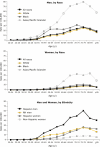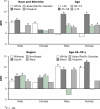National trends and disparities in the incidence of hepatocellular carcinoma, 1998-2003
- PMID: 18558024
- PMCID: PMC2483571
National trends and disparities in the incidence of hepatocellular carcinoma, 1998-2003
Abstract
Introduction: Previous studies indicate that the incidence of hepatocellular carcinoma in the United States is increasing. These reports, however, have contained limited information on population groups other than whites and blacks.
Methods: We assessed recent incidence rates and trends for hepatocellular carcinoma by using newly available national data from cancer registries participating in the Centers for Disease Control and Prevention's National Program of Cancer Registries and the National Cancer Institute's Surveillance, Epidemiology, and End Results Program. Data from registries in 38 states and the District of Columbia met our criteria; these data covered 83% of the U.S. population. We computed age-adjusted incidence rates and annual percentages of change from 1998 through 2003.
Results: The registries that we used reported 48,048 cases of hepatocellular carcinoma (3.4 cases per 100,000 population per year) for the study period. Whites accounted for three-fourths of cases. The incidence rate for blacks was 1.7 times higher than that for whites, and the rate for Asians/Pacific Islanders was 4 times higher than that for whites. Hispanics had 2.5 times the risk of non-Hispanics. Among Asian/Pacific Islander subgroups, rates were highest for people of Vietnamese and Korean origin. For all races/ethnicities combined, the annual percentages of change were 4.8% for males and 4.3% for females (P < .05). The annual percentage of change was highest for people aged 45-59 years (9.0%, P < .05). The annual percentage of change for Asians/Pacific Islanders was statistically unchanged.
Conclusion: We document rising incidence rates of hepatocellular carcinoma in the United States during a time when the overall incidence of cancer has stabilized. Efforts to collect representative etiologic data on new hepatocellular carcinoma cases are needed to enable better characterization of trends and to guide the planning and evaluation of prevention programs.
Figures
References
-
- Parkin DM. The global health burden of infection-associated cancers in the year 2002. Int J Cancer. 2006;118(12):3030–3044. - PubMed
-
- Carriaga MT, Henson DE. Liver, gallbladder, extrahepatic bile ducts, and pancreas. Cancer. 1995;75(1 Suppl):171–190. - PubMed
-
- Cancer facts and figures. Atlanta (GA): American Cancer Society; 2005.
-
- U.S. Cancer Statistics Working Group. United States cancer statistics: 2002 incidence and mortality web-based report version. Atlanta (GA): Centers for Disease Control and Prevention, and National Cancer Institute; 2005. [Accessed March 1, 2006]. http://www.cdc.gov/cancer/npcr/uscs .
-
- El-Serag HB. Hepatocellular carcinoma: an epidemiologic view. J Clin Gastroenterol. 2002;35(5 Suppl 2):S72–S78. - PubMed
MeSH terms
LinkOut - more resources
Full Text Sources
Medical
Miscellaneous



